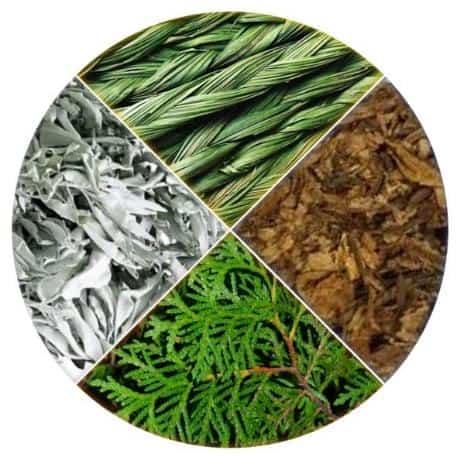In the Presence of Wisdom: Voices of the Land
Taken from the foreword of Voices of the Land, 1993. When the Elders met at the gathering “The Voice of

Within Indigenous cultures, the world is intricately woven with sacred traditions and wisdom passed down through generations. Among these cherished teachings are the Four Sacred Medicines, each gifted by the Creator to the Indigenous Peoples. These medicines, deeply rooted in spiritual and cultural significance, are revered for their healing properties and the spiritual connections they foster. They hold a unique place in Indigenous ceremonies, daily life, and the quest for inner and communal harmony.

1. Tobacco (Semma):
Tobacco, known as “Semma,” is the first of the Four Sacred Medicines. It holds a central role in Indigenous rituals and ceremonies. Traditional tobacco is used for smudging and offered as a gesture of reverence in almost every aspect of life. This sacred herb is a conduit for communicating with the spirit world, a medium through which thoughts and feelings are conveyed. When tobacco is offered, prayers are shared not only for oneself but also for family, relatives, and the collective community
.
2. Cedar (Giizhgaandak):
Cedar, or “Giizhgaandak,” is the second of the Four Sacred Medicines. It is a versatile plant with a variety of applications. Cedar is a critical element in the smudging ceremony, where it serves to purify the surroundings. It is also used to create medicinal tea. When cedar crackles in the fire alongside tobacco, it is believed to capture the attention of the spirits, signaling the offering made to them.
3. Sage (Mshkodewashk):
Sage, known as “Mshkodewashk,” is the third Sacred Medicine. It plays a significant role in cleansing and preparing individuals for ceremonies, teachings, and meetings. Sage is regarded as a potent tool for releasing troubled thoughts and eliminating negative energy. The act of smudging with sage is a deeply spiritual experience that refreshes the mind and soul.
4. Sweetgrass (Wiingashk):
Sweetgrass, the fourth Sacred Medicine, is often referred to as the “sacred hair of Mother Earth.” Its delightful aroma evokes a sense of gentleness, love, and kindness—qualities symbolizing the Earth’s affection for its inhabitants. Sweetgrass gains strength when braided, signifying unity and harmony. It is used in ceremonial practices, where its fragrance serves to purify and uplift the spirit.
Conclusion:
The Four Sacred Medicines are a testament to the profound connection between Indigenous Peoples and the natural world. These gifts from the Creator are not merely plants but sources of healing, spiritual enrichment, and cultural identity. The sacred medicines are woven into the tapestry of Indigenous life, bridging the physical and spiritual realms. In the smudging ceremonies, offerings, and everyday applications of these medicines, Indigenous communities find strength, solace, and a deep connection to their cultural roots. The Four Sacred Medicines are not only reminders of their profound past but also guideposts for a brighter, more harmonious future.
Taken from the foreword of Voices of the Land, 1993. When the Elders met at the gathering “The Voice of

Adapted from Association of Friends, August 1995 Art, a lifelong resident of Birch Island, exemplifies commitment and community engagement. Married to
Grandmother’s Voice: Creating opportunities for Indigenous community members to share their teachings, healing practices and traditional handicraft creation with the broader community.
Elevating Indigenous Knowledge and Culture across Halton Region has been the foundation of our organization. Collectively, we continue to serve as a beacon for building awareness and fostering connectedness. Rooted in our Nation’s origins, we are dedicated to enhancing capacity and illuminating the landscape of Indigenous social services and determinants of health. Join us on this transformative journey as we strive to strengthen bonds, raise awareness, and contribute to the well-being of our communities.
Grandmother’s Voice International Business #799454954RC0001


© 2024 All Rights Reserved.